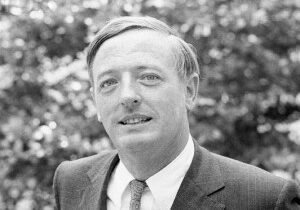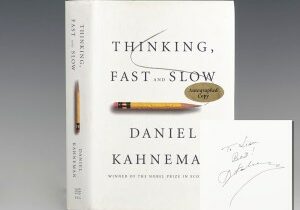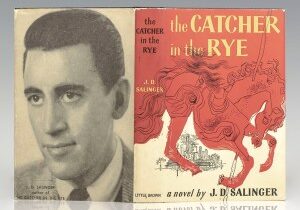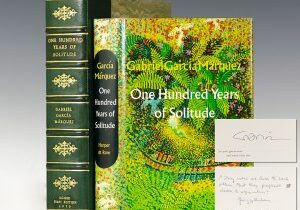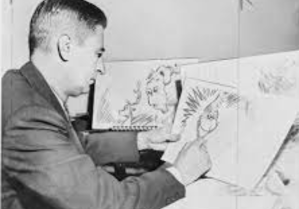Born in Ireland in 1882, James Joyce is regarded as one of the most influential and important writers of the 20th century. His novel Ulysses (1922) is a landmark in which the episodes of Homer’s Odyssey are paralleled in a variety of literary styles, particularly stream of consciousness and his other well-known works include A Portrait of the Artist as a Young Man (1916) and Finnegans Wake (1939).

First edition of Joyce’s masterpiece Ulysses one of 750 numbered copies printed on handmade paper from a total edition of 1000 copies
During Joyce’s travels, he came in contact with Sylvia Beach, proprietor of the world renowned bookstore Shakespeare & Company. Despite being rebuffed by both American and English audiences for perceived obscenities, Joyce’s masterpiece Ulysses was published by Beach in 1922. Joyce’s struggle to find a publisher is a comic irony considering that Ulysses is “[u]niversally hailed as the most influential work of modern times” (Grolier Joyce 69). Ulysses was an immediate success. The first printing sold out, and “within a year Joyce had become a well-known literary figure. Ulysses was explosive in its impact on the literary world of 1922” (de Grazia, 27). Even so, the book continued to face difficulties in global reception. It was banned in the U.K. and was prosecuted for the obscenity in the Nausicaa episode (Ellmann, 1982). Joyce’s inspiration for the novel began as a young boy reading Charles Lamb’s Adventures of Ulysses and writing an essay entitled “My Favorite Hero” after being impressed by the wholeness of the character (Goreman, 1939). The idea for the novel grew from a story in Dubliners in 1906, which Joyce expanded into a short book in 1907, before reconceptualizing it as the heady novel in 1914 (Ellmann, 1982).
The book can initially seem unstructured and chaotic, and Joyce admitted that he “put in so many enigmas and puzzles that it will keep the professors busy for centuries arguing over what I meant” (The Observer, 2000). The French translator Stuart Gilbert published a defense of Ulysses shortly after its publication in which he supported the novel’s use of obscenity and explained its internal structure and links to Homer’s Odyssey against accusations of ambiguity. Every episode, Gilbert explained, is connected to the Odyssey by theme, technique, and correspondence between characters. Another instance of Ulysses’ literary contribution is his use of stream-of-consciousness, a technique employing carefully structured prose, both humorous and charactering, and involving puns and parodies. Joyce was a precursor to the use of stream of consciousness in the later decades. Similar narrative techniques were used by his contemporaries Virginia Woolf, William Faulkner, and Italo Svevo. Their style can be better characterized as an “interior monologue, rather than stream of consciousness, is the appropriate term for the style in which [subjective experience] is recorded, both in The Waves and in Woolf’s writing generally” (Stevenson, 1992).

“The Object Of The Artist Is The Creation Of The Beautiful. What The Beautiful Is Is Another Question”: First Edition Of James Joyce’s Portrait Of The Artist As A Young Man; In The Rare Original Dust Jacket.
Six years prior to the publication of Ulysses, Joyce was able to publish A Portrait of the Artist as a Young Man, a semi-autobiographical novel which describes the formative years of the life of Stephen Dedalus (Joyce’s alter ego). It was published first in book format in 1916 by B. W. Huebsch, New York. The first British edition was published by the Egoist Press in February 1917. The novel was well received, ultimately being chosen by Modern Library as one of 100 greatest novels of the twentieth century. The novel represents Joyce’s religious and intellectual awakening, as he struggled to navigate his relationship with the Catholic Church and his identity as an Irishman. In many ways, Joyce’s reflections here set the tone for his life as a traveler throughout Europe. This first edition of his first novel is rare especially in this condition, without any of the restoration usually encountered.

“Let Us Leave Theories There And Return To Here’s Hear”: Signed Limited Edition Of James Joyce’s Finnegan’s Wake.
After the publication of Ulysses and his integration into the literary culture of Paris, a mature Joyce began writing what would be his final publication of his lifetime, Finnegan’s Wake. He began writing almost immediately after the publication of Ulysses, serializing his new avant-garde work in Parisian literary journals under the title “fragments from Work in Progress”. The actual title of the work remained a secret until the book was published in its entirety, on 4 May 1939, roughly two years prior to his death in 1941. The work has assumed a preeminent place in English literature. Anthony Burgess praised the book as “a great comic vision, one of the few books of the world that can make us laugh aloud on nearly every page.”
Harold Bloom called the book “Joyce’s masterpiece”, and wrote that “[if] aesthetic merit were ever again to center the canon [Finnegans Wake] would be as close as our chaos could come to the heights of Shakespeare and Dante.” Like A Portrait of An Artist, Finnegan’s Wake is considered to be one of the 100 greatest novels of the twentieth century, according to Modern Library. Despite its present fame, its initial reception was critical, due to the novel’s fragmentary, surreal and dreamlike structure. A stunning example of the experimental stream of consciousness style that was developed in early 20th century literature. This particular first edition copy is a signed limited edition, number 251 of only 425 large-paper copies signed by Joyce. A superior example of James Joyce’s brilliant literary style and prose which stunned critics and readers alike.
In addition to rare first editions featured above, browse our complete collection of James Joyce here.

